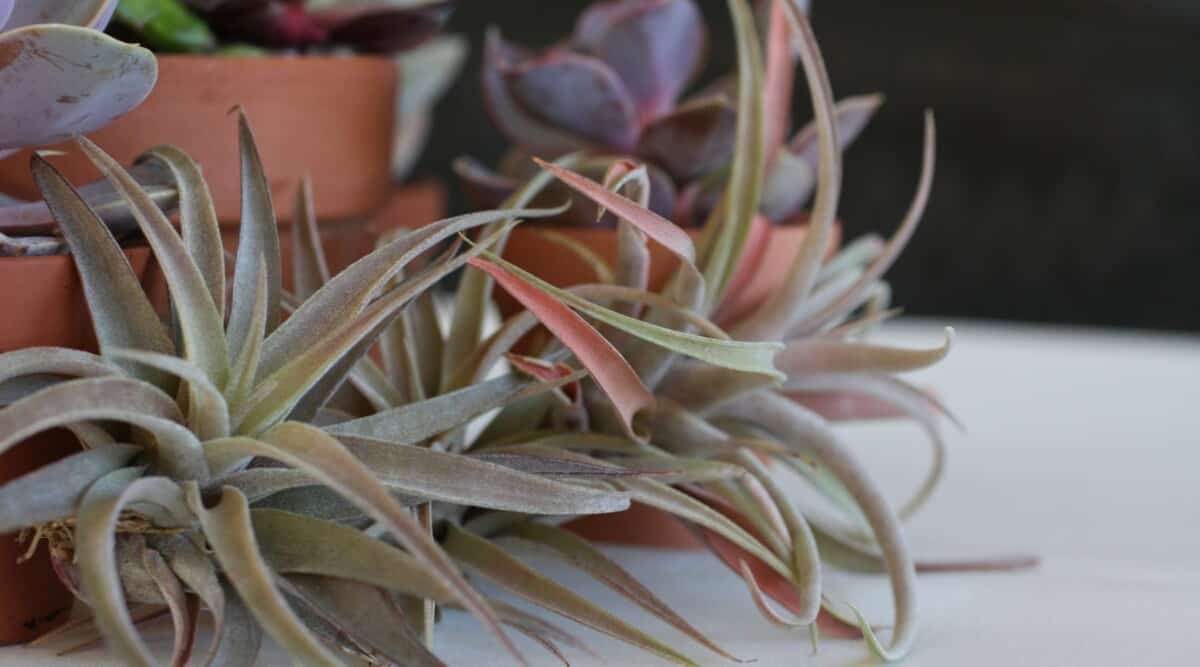
11 Ways to Tell if Your Air Plant Is Healthy
Air plants (Tillandsia) are unique and hassle-free indoor plants that provide great aesthetic beauty for your home. These distinctive plants range in size, come with beneficial health attributes for your home during the photosynthesis process, and require very little maintenance on your part, making the plants attractive for busy professionals. Since air plants require less upkeep than other plants, how can you tell if your air plant is healthy?
This post may contain affiliate links, and I love all the products I promote.
To tell if your air plant is healthy, hydration of the plant is crucial to prevent underwatering. Regularly check for discolored leaves or dry or wet rot to tell if the plant is not receiving enough moisture or too much. If an air plant blooms and displays fuzz, this is a sign of good health.
There are many ways you can check to see if your air plant is healthy and most of them can be done simply with a visual inspection of your air plant. Some surprising things can easily make them unhealthy. Read on to find out more about 11 easy ways that you can check your air plant’s overall health.
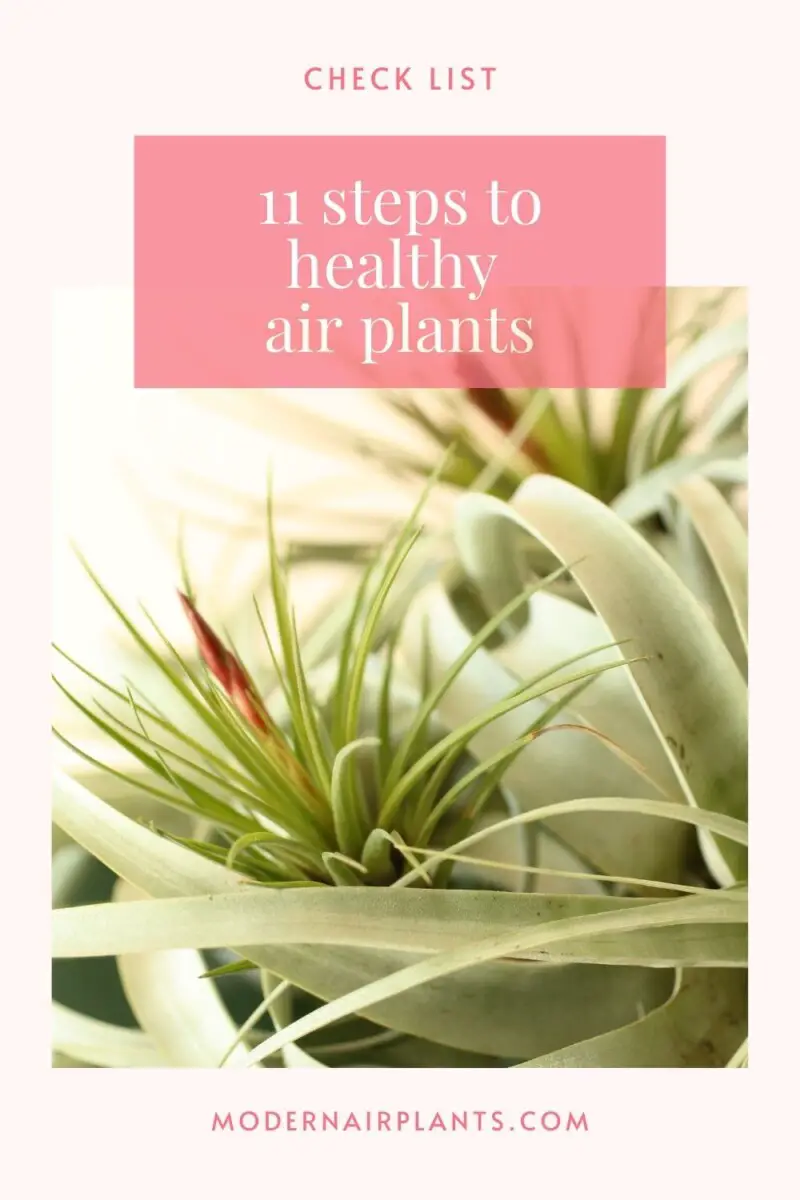
1- Check the Leaf Color
Air plants do not require large amounts of water, but the plants require just the right amount to stay healthy. One sign of air plant dehydration is the discoloration of the leaves. Air plant leaves can turn brown or lose their original luminosity when the plant is not receiving enough water.
You may also notice that the leaves’ brown tips have a crinkled texture, and the tips fall off when you touch them. To correct this problem, you must water your air plant more frequently. Similarly, discolored leaves can also be a sign that the plant is receiving too much water. If this is the case, and watering did not correct the problem, it helps remove the air plant from the unit and drain out any excess water.
Leaf discoloration could also signify that your air plant is receiving too much sun (more on this below). If you have an air plant that has bloomed, you may notice a large amount of discolored or even dead leaves. This is completely normal since the air plant is now diverting much of its resources to a new slate of young air plants.
2- Make Sure the Air Plant Is Hydrated
Of all the common problems seen with air plants, improper hydration is probably the most common. This plant requires a regular dose of water at least once a week to maintain optimal health. But when you are busy with daily activities, it is easy to forget this crucial step. A light misting of water to the point of runoff is all an air plant needs.
Your plant will usually let you know if it does not receive enough water with discolored leaves or leaves that curl up towards the edges. But since there are many air plants species, it is important to know how the more common species receive water.
If you are in an arid region such as the desert, you may have a type of air plant known as Tillandsia xerographica. This type of air plant is regional to warm and arid environments where precipitation is minimal. This species has larger and thicker leaves to ensure that water is absorbed more frequently throughout the air plant. For this species, misting is the best method to use due to this species’ larger size; be sure to allow the excess water to drain off.
Take a look at this video that provides further details about air plants and proper hydration:
https://www.youtube.com/watch?v=95nlQ7yPvbA
3- Is the Air Plant Straight or U-Shaped?
Speaking of curled-up leaves, this is not always a good sign with an air plant. Often, a plant will change its shape when there are signs of internal distress. Since an air plant did not need soil and granted the plant has access to sunlight, this could be an indicator of too much or too little water.
Although photosynthesis will give a plant a majority of its nutrients, moisture is still essential to ensure that the plant can properly synthesize its nutrients. When there is a lack of water, an air plant will typically curl up into a u-shape since there are not enough vital nutrients for the plant to support its own weight.
Be sure to water your air plant if you notice this shape. If your air plant has a straight shape, this is a sign of good health. If you have a Tillandsia xerographica, leaf curling is typically normal for this species, especially as the plant begins to grow, but the stem still should have a straight form.
4- Check for Dry or Wet Rot
Just as vital as water is to an air plant, water can also be a slippery slope in air plant care. This is why it is recommended to submerge an air plant in water once a week and allow the remaining water to drain off the plant completely; this is crucial to avoid what is known as wet rot. But rot can also have another meaning for this type of plant–lack of proper airflow.
Dry rot can affect air plants due to these plants’ need to receive an adequate amount of air as their name suggests. Air plants are primarily nocturnal plants, which means most of their biological processes occur at night from the stores of that day’s sunlight absorption. This means that air plants need adequate space with ample air to breathe properly. If the plants are left in enclosed spaces, dry rot can lead to a lack of air.
5- Is Your Air Plant Free of Pests?
Pests are problems that occur with any plant, including indoor plants like air plants. This type of plant typically gets attacked by two kinds of insect: mealybugs and scale insects. Mealybugs are tiny, white-colored bugs that find their way into homes in search of indoor plants. Once the bugs find an air plant, the pests extract the plants’ juices and enzymes and reproduce rapidly.
Scale insects are similar to mealybugs in appearance and behavior. These pests also feed off of an air plant’s internal enzymes. It is important to immediately find a safe pesticide to use against these insects to prevent your air plant from dying. You can typically see or feel the bugs clustered around the stem of an air plant.
Because the leaves of air plants are susceptible, it is recommended to use an organic pesticide to fight against pests. You can easily use diatomaceous earth (DE powder) to destroy a pest infestation. This powder is generally safe for plants and works by piercing an insect’s exoskeleton and causing the pest to dehydrate rapidly. Once the infestation is removed, you can soak the air plant in water to remove the white powder.
6- Check for Sunburn
Just like there is a thing as too much water, there can also be a problem providing an air plant with too much sunlight. Like all plants, air plants need an adequate amount of sunlight to maintain health, but these types of plants are primarily indoor; therefore, only a few hours of sunlight is required.
Furthermore, an air plant does better with indirect sunlight instead of direct sunlight that can be harsher on the plant’s leaves. Try to avoid placing your air plant in window seals that receive direct sun rays as this can cause sunburn. An air plant suffering from sunburn will usually have yellow to orange colored leaves or even white leaves.
To fix this problem, move the plant into the room’s interior where only faint amounts of sunlight can reach the leaves–just enough for photosynthesis purposes. You could also consider providing artificial light for your air plant. This suggestion can also make for a great decoration since you could hang your air plant terrarium from a fluorescent light.
7- Check for Leaf Fuzz
Air plants are known for their thick, green leaves and the characteristic white “fuzz” that clumps along with the leaves. This fuzz is probably a little alarming on the first view, yet this is a natural part of an air plant called trichomes. This white, fur-like substance on the leaves is essential for air plant health and is a definite sign that your plant is healthy.
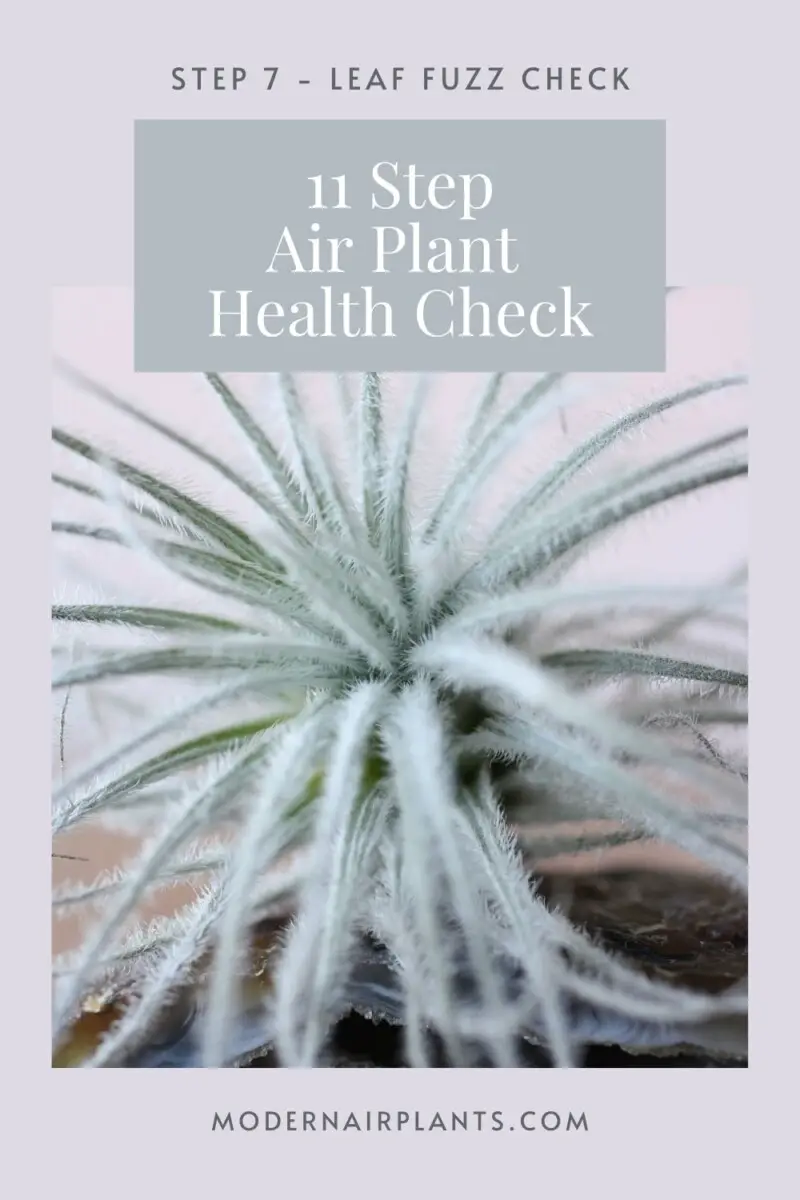
Trichomes help absorb water from the surrounding air and block harmful radiation from the sun. This would normally be soil with regular plants, but air plants need no soil to grow. Have you ever wondered why air plants require such small amounts of water? Trichomes can pull essential nutrients and moisture out of the air to keep the air plant healthy.
If you do not notice air plant fuzz, this could signify that the plant is not as healthy as it could be. For dry areas like the American Southwest, there isn’t enough moisture in the air for the trichomes to operate properly. It helps submerge your air plant in water for a couple of hours once a week to replace the moisture the trichomes cannot receive from the air. Be sure to allow the air plant to dry afterward to avoid wet rot completely.
There are other signs that an air plant could be unhealthy even with fuzz present, but as long as trichomes are on the plant, all is usually well.
8- Make Sure the Leaves Are Not Wilted
If your air plant’s leaves are wilted, this could be a sign of one or multiple problems occurring at once. Wilted leaves are most commonly a sign of overheating in a plant’s surrounding environment. Most frequently, this can occur from leaving an air plant exposed to direct sunlight for hours at a time. Wilting of leaves can occur instead of discolored leaves from sunburning, or both conditions can occur at once.
Overheating is typically a common reason that air plant leaves wilt, but the main reason for wilting is typically related to inadequate water intake. This can be a little confusing to air plant owners because it is fundamentally true that air plants commonly absorb water out of the atmosphere. But sometimes, there isn’t enough water in the air or, if your air plant is enclosed in a terrarium, the airflow needed for the trichomes to function is limited.
One way to test the cause of wilted leaves is to submerge an air plant in a water container. Leave the plant submerged for one to two hours, and then suspend the plant from a piece of string above a towel to air dry. This rapid absorption of water can usually fix dehydration issues with an air plant and revive the leaves.
Alternatively, you could take your air plant out of its terrarium for about a week to allow maximum airflow to the trichomes and see if this fixes the problem.
9- Is Your Air Plant Blooming?
The sign of an air plant blooming is bittersweet; this is a sign of the plant’s maximum health and the beginning of an air plant’s final life stage. When an air plant blooms, this is a beautiful sight to behold and a sign that you have taken utmost care of the plant over its life cycle. Typically, anywhere from 1-4 “pups” will grow along the base of the blooming air plant, which you can then separate from the main plant after a few weeks.
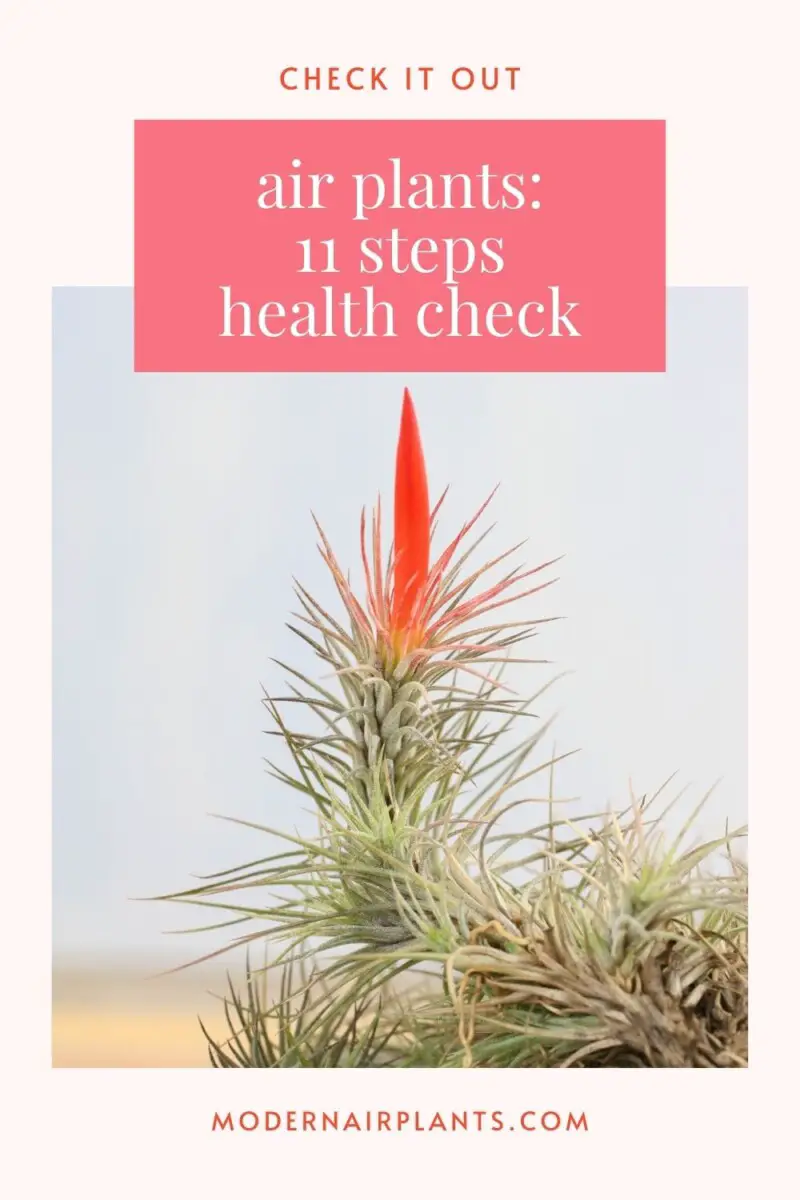
An air plant will usually only bloom once in its lifetime, and this process could take a long time depending on the species of tillandsia. Once an air plant blooms, you will still need to provide the plant with water without damaging the bloom. This can be achieved by misting a bloomed air plant’s leaves and allowing the excess water to run off to avoid wet rot.
If you have an air plant blooming its beautiful array of flowers, you can rest assured that you have kept the plant 100% healthy. You will also have new air plants to take care of once you cut off the pups.
10- Is Your Air Plant Absorbing the Right Kind of Water?
A crucial detail to remember with air plant care is ensuring that the plant receives the right kind of water. While an air plant will receive most of its water from the air, you still need to mist or submerge an air plant in the water at least once a week and 2-3 times per week in dry climates. Bottled spring water is the best kind of water for misting and soaking an air plant.
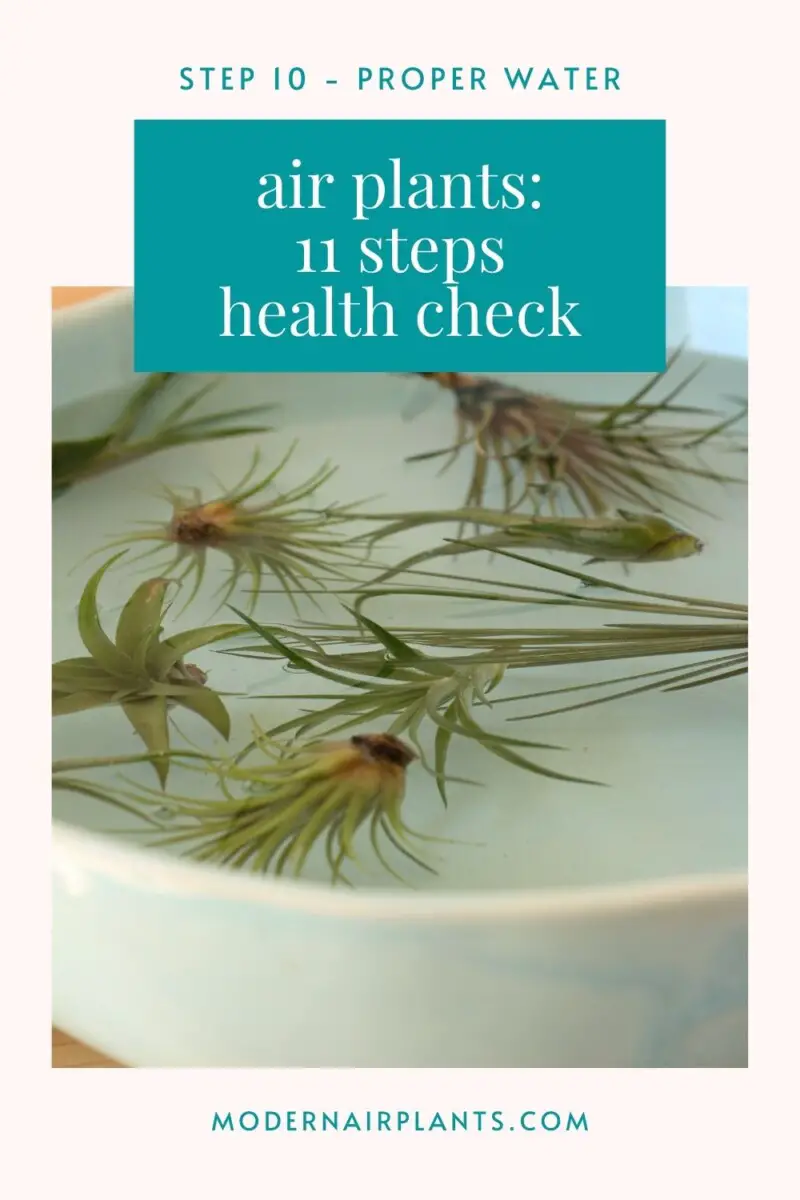
Distilled water should be avoided since this kind of water lacks the essential minerals that plants need to thrive. If you only have tap water available, this can work as well but be sure to allow the tap water to sit overnight to remove the water’s chlorine to prevent harming your air plant with chemicals.
If an air plant receives the wrong kind of water, you can usually spot this by discolored or wilted leaves. In more extreme situations, your air plant may not grow properly if you consistently use the wrong type of water.
11- Is Your Air Plant Trimmed and Clean?
Finally, it is also helpful to look at your air plant and make sure it is clean and trimmed properly. This step is most common for air plants that have passed the blooming cycle and are in the final life stage. Once your air plant has bloomed, if you continue to take care of the plant, you may notice that the mother plant has lost most of its luster. This is common since the plant is producing new air plants as buds.
Be sure to regularly trim these leaves to ensure that the forming pups have direct access to airflow. An after bloom air plant may also have a dead flower attached in the middle that you can easily clip away with a pair of pruning shears. If an after bloom air plant is still producing pups, the plant is not dead and should still be cleaned up and trimmed to allow the pups to remain healthy.
Additionally, if the roots of an after bloom are no longer yellow in color, you can trim away the dead parts to give the plant a better appearance. Never throw away an after bloom air plant because even though the plant is losing its luster as it diverts resources to pups, the plant is still very much alive and needs some upkeep.
Conclusion
There are many details you can check to make sure your air plant is healthy. The main issue commonly seen with unhealthy air plants is either not enough water or far too much. Always be sure to submerge your air plant in water for a few hours each week. Let the air plant thoroughly dry to avoid wet rot. Indirect sunlight is key, and be sure to continue caring for an air plant after it blooms.
Air plants are low maintenance but do need assistance occasionally.
Sources
- Wikipedia: Tillandsia
- NCBI.gov: Dispersal limitation of Tillandsia species correlates with rain and host structure in a central Mexican tropical dry forest
- University of Florida: Air Plant: Tillandsia
- Penn State University: Tillandsia (Air Plants)
- Wikipedia: Mealybug
- Wikipedia: Scale insect
- NDSU: Air Plants
- American Journal of Botany: Effects of Wilting on the Subsequent Intake of Water by Plants
- Wikipedia: Tillandsia xerographica
- Wikipedia: Diatomaceous earth

